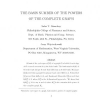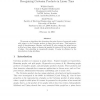44 search results - page 3 / 9 » The distinguishing number of Cartesian products of complete ... |
DM
1998
13 years 4 months ago
1998
We prove the conjecture of Abbott and Katchalski that for every m ≥ 2 there is a positive constant λm such that S(Kd mn) ≥ λmnd−1 S(Kd−1 m ) where S(Kd m) is the length o...
DM
2010
13 years 4 months ago
2010
The Grundy number of a graph G, denoted by (G), is the largest k such that G has a greedy k-colouring, that is a colouring with k colours obtained by applying the greedy algorithm...
CORR
2010
Springer
13 years 4 months ago
2010
Springer
The oriented chromatic number of an oriented graph G is the minimum order of an oriented graph H such that G admits a homomorphism to H. The oriented chromatic number of an undire...
DM
1998
13 years 4 months ago
1998
A basis of the cycle space C(G) of a graph G is h-fold if each edge of G occurs in at most h cycles of the basis. The basis number b(G) of G is the least integer h such that C(G) ...
DM
2007
13 years 4 months ago
2007
We present an algorithm that determines the prime factors of connected graphs with respect to the Cartesian product in linear time and space. This improves a result of Aurenhammee...


